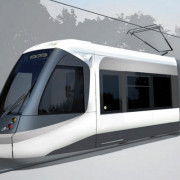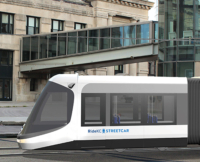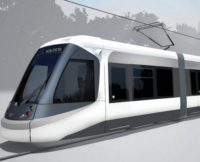Streetcar Authority endorses exterior colors, design
They won’t be Chiefs red, or KU crimson and blue, or MU black and gold. Instead, Kansas City’s new streetcars will be white, black and silver. Some critics say boring. Or worse, Oakland Raiders colors.
But those in charge think Kansas City’s colors are instead sleek, sophisticated and elegant.
That’s how Lynn Horsley, reporter for The Kansas City Star, began her story today about the selection of base exterior colors for the new Downtown streetcar line.
Kansas City’s Streetcar Authority voted 6-1 Thursday to approve the base exterior colors — what the professionals described as white, graphite and platinum — for the four vehicles being purchased for the Downtown starter line.
Authority members emphasized that those base colors will be accented with other bolder colors, graphics, logos and wraps as time goes by. They said they were making this decision now, before the full streetcar branding is finalized, to meet the manufacturer’s deadline to paint the vehicles.
“We’re really thinking of this as the jewel of Kansas City transportation,” said Megan Stephens, president and partner with Willoughby Design, which researched streetcar colors nationally and globally and recommended the color scheme to the authority.
“Something that’s timeless, that’s sophisticated, something that’s a canvas for our city moving forward for the next 30 years.”
Most Streetcar Authority members thought the exterior colors were classic, classy and would give the city maximum flexibility for future accent colors, logos and promotions.
Authority member Liz Serpa-Flook of the Cordish Co. said the neutral background colors look “cool” and will allow future graphics to pop and grab people’s attention.
“For selling sponsorships, you want to be able to do that,” she said.
But not everyone was convinced.
“I think we could be a lot brighter,” said authority member Jim Miller with DST Realty Inc. “I think these cars need to be seen coming down the road. They can still be modern and sleek and have color. … I just think color is so important, and I just don’t think these colors are going to excite anybody.”
Miller was the lone member who voted against the color recommendation.
Authority member David Johnson said he, too, was originally lukewarm on these muted colors. He had envisioned that the vehicles would be painted bright red. But gradually, he grew to appreciate the recommended color scheme and the flexibility it offers for future graphics and marketing overlays.
Others agreed and pointed out that luxury vehicles, the iPhone, the American Express Platinum card and other classic designs are often white, black and gray — and stand the test of time.
“When’s the last time you saw a bright red BMW?” authority member Matt Staub asked, arguing that the group’s choice makes both practical and aesthetic good sense for the streetcar’s long-term future, especially as it is projected to expand into neighborhoods beyond downtown that might object to bold, loud colors.
Some did raise questions about safety. Serpa-Flook wondered whether people will always see the muted colors in the distance and realize they need to get out of the way, especially since streetcars are quieter than a bus.
“I don’t think anyone is going to miss the vehicle when it’s coming down the street,” Johnson said, adding that these are quite large and hard to miss, at 79 feet long and 10 feet tall.
Kansas City’s streetcar construction is to finish in the latter part of 2015.
Other cities have clearly gone a different route with their color choices. Cincinnati has chosen a marigold yellow color for its new streetcar vehicles.
Heritage streetcars, usually used in tourist districts, are often bold red and yellow.
Portland, Ore., and Seattle, which were early adopters of the modern streetcar after 2001, have used a rainbow’s worth of colors for their streetcars. But critics said those color palettes don’t have much of a unifying theme and don’t lend themselves easily to marketing opportunities.
Meanwhile, Stephens said, the Paris streetcar is mostly white and blends beautifully with the French city’s other transit systems.
Stephens also pointed out that the recommended colors mimic those of some of Kansas City’s iconic structures, including the Bloch Building at the Nelson-Atkins Museum of Art and the Kauffman Center for the Performing Arts.
The Streetcar Authority also approved using a bright blue color for the interior seats of the vehicles. It said blue is a color common to nearly all the other transportation agencies in the region, including the Area Transportation Authority and MAX buses, and will help connect the streetcar to those other regional assets.



